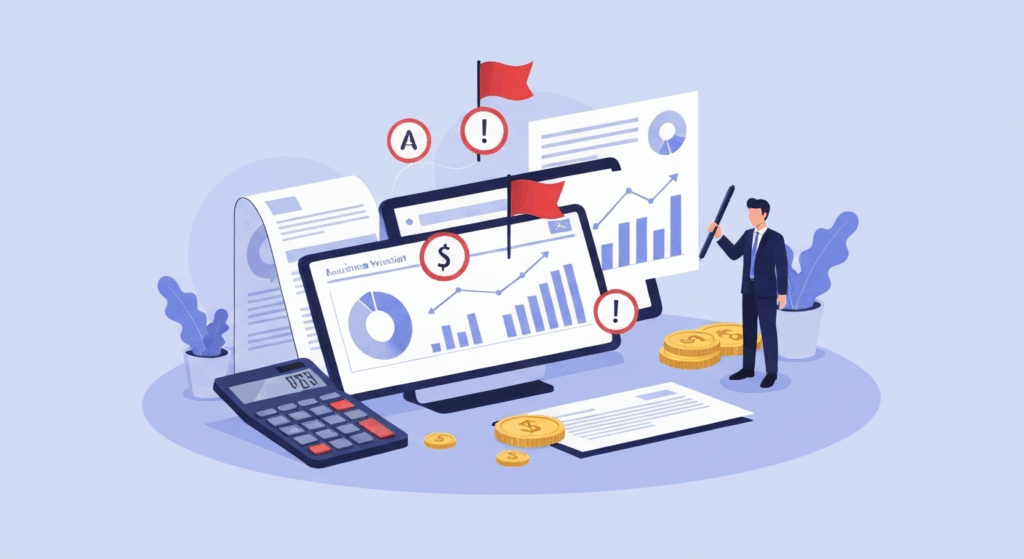7 Critical Business Valuation Mistakes That Cost Owners Millions When Selling
When it comes time to sell your business, getting the valuation right can mean the difference between a life-changing payday and leaving millions on the table. Unfortunately, business valuation mistakes are incredibly common, with studies showing that up to 70% of business owners significantly undervalue or overvalue their companies during the sale process.
Whether you’re a first-time seller or have been through the process before, understanding these critical valuation errors can help you maximize your business’s sale price and avoid costly missteps that could derail your transaction entirely.
Why Business Valuation Accuracy Matters More Than Ever
In today’s competitive M&A market, buyers are more sophisticated than ever. They have access to extensive market data, professional advisors, and detailed due diligence processes. A single valuation mistake can:
- Scare away serious buyers with unrealistic pricing
- Leave substantial money on the table with undervaluation
- Extend your time on market, reducing buyer interest
- Create negotiation disadvantages during the sale process
- Result in deal collapse during due diligence
According to recent industry data, businesses that avoid common valuation mistakes sell for an average of 15-25% more than those that don’t, and complete transactions 40% faster.
Mistake #1: Relying Solely on Rules of Thumb and Industry Multiples
One of the most dangerous business valuation errors is oversimplifying the process by relying exclusively on industry rules of thumb or basic revenue multiples. While these can provide a starting point, they ignore the unique factors that make your business valuable.
Why This Mistake Happens
Business owners often hear that “restaurants sell for 2-3x revenue” or “SaaS companies trade at 5-8x revenue” and assume these broad generalizations apply to their specific situation. This oversimplification ignores crucial factors like:
- Profit margins and cash flow patterns
- Growth trajectory and market position
- Customer concentration and retention rates
- Operational dependencies and systems
- Market conditions and timing
The Real Cost
A manufacturing company we recently evaluated was initially priced using a “3x EBITDA” rule of thumb, suggesting a $3 million valuation. However, proper analysis revealed strong recurring revenue streams, proprietary technology, and excellent management systems that justified a $4.8 million sale price – a 60% increase.
How to Avoid This Mistake
- Use multiple valuation methods (asset-based, income-based, market-based)
- Consider your business’s unique value drivers
- Analyze comparable sales with similar characteristics
- Factor in current market conditions and buyer demand
- Engage professional appraisers for complex valuations
Mistake #2: Ignoring the Impact of Owner Dependency
Many business owners fail to account for how heavily their company depends on their personal involvement, leading to significant overvaluation and buyer concerns.
The Owner Dependency Problem
If your business can’t operate successfully without you, buyers will apply substantial discounts to account for:
- Transition risk and operational disruption
- Customer relationship dependencies
- Key decision-making bottlenecks
- Institutional knowledge gaps
- Supplier and vendor relationships tied to you personally
Quantifying the Impact
Businesses with high owner dependency typically sell for 20-40% less than similar companies with strong management teams and systems. A $2 million business might only fetch $1.2-1.6 million if buyers perceive significant owner dependency risk.
Solutions to Reduce Owner Dependency
- Develop and document standard operating procedures
- Build a strong management team with decision-making authority
- Diversify customer relationships beyond personal connections
- Create systems for key business processes
- Establish vendor relationships in the company name
- Begin transitioning responsibilities 12-18 months before sale
Mistake #3: Failing to Properly Normalize Financial Statements
One of the most technical yet critical business valuation mistakes involves presenting financial statements without proper normalization adjustments, which can dramatically understate your company’s true earning potential.
What Financial Normalization Means
Normalization involves adjusting your financial statements to reflect what earnings would look like under new ownership. Common adjustments include:
- Owner compensation adjustments: If you pay yourself above or below market rates
- Personal expenses: Removing non-business expenses run through the company
- One-time events: Adjusting for unusual income or expenses
- Related party transactions: Normalizing below-market rent or other arrangements
- Discretionary expenses: Identifying optional spending that new owners might eliminate
Real-World Example
A retail business showed $200,000 in annual profit, but normalization revealed:
- Owner salary was $40,000 above market rate: +$40,000
- Personal vehicle expenses: +$15,000
- Family member on payroll (minimal work): +$25,000
- Excessive travel and entertainment: +$20,000
Normalized earnings: $300,000 (50% increase)
Best Practices for Financial Normalization
- Work with experienced CPAs familiar with business sales
- Document all adjustments with clear explanations
- Provide 3-5 years of normalized statements
- Be conservative and defensible in your adjustments
- Prepare supporting documentation for each adjustment
Mistake #4: Overvaluing Intangible Assets and Goodwill
While intangible assets can be valuable, many business owners make the mistake of overestimating their worth or failing to properly substantiate their value to buyers.
Common Intangible Asset Overvaluations
- Customer lists: Assuming all customers have equal value
- Brand recognition: Overestimating local or niche brand value
- Proprietary processes: Valuing undocumented or easily replicated methods
- Employee relationships: Assuming key employees will stay post-sale
- Location advantages: Overvaluing lease terms or location benefits
How Buyers Actually Value Intangibles
Sophisticated buyers evaluate intangible assets based on:
- Documented and defensible competitive advantages
- Measurable impact on revenue and profitability
- Transferability to new ownership
- Legal protection (patents, trademarks, contracts)
- Sustainability and market durability
Properly Valuing Your Intangible Assets
- Document all proprietary processes and systems
- Quantify the financial impact of each intangible asset
- Obtain legal protection where possible
- Create transferable customer and vendor contracts
- Build systems that don’t depend on specific individuals
Mistake #5: Timing the Market Incorrectly
Market timing significantly impacts business valuations, yet many owners fail to consider broader economic and industry trends when valuing their companies.
Market Factors That Affect Valuations
- Economic cycles: Recession vs. growth periods
- Industry trends: Growing vs. declining sectors
- Interest rates: Impact on buyer financing and required returns
- Buyer demand: Strategic vs. financial buyer markets
- Regulatory environment: Industry-specific regulations and changes
2024-2025 Market Considerations
Current market conditions present unique challenges and opportunities:
- Higher interest rates affecting buyer financing
- Increased focus on cash flow and profitability
- Technology disruption creating both risks and opportunities
- Labor market challenges affecting operational valuations
- Supply chain considerations impacting manufacturing businesses
Strategic Timing Considerations
- Monitor industry M&A activity and multiples
- Consider your business’s growth trajectory
- Evaluate personal and financial readiness
- Assess competitive landscape changes
- Plan for 12-18 month sale process
Mistake #6: Inadequate Comparable Analysis
Many business owners attempt to value their companies by looking at inappropriate comparables or fail to adjust for significant differences between their business and supposed “comps.”
Common Comparable Analysis Errors
- Using publicly traded companies to value small private businesses
- Comparing businesses of vastly different sizes
- Ignoring geographic and market differences
- Failing to adjust for profitability and growth differences
- Using outdated transaction data
What Makes a True Comparable
Effective comparable analysis requires businesses that share:
- Similar size (revenue and employee count)
- Comparable profit margins and growth rates
- Similar business models and customer bases
- Geographic and market similarities
- Recent transaction timing (within 2-3 years)
Improving Your Comparable Analysis
- Use professional databases for transaction data
- Focus on businesses sold within your region
- Adjust multiples for size, growth, and profitability differences
- Consider both strategic and financial buyer transactions
- Work with brokers who have relevant industry experience
Mistake #7: Emotional Attachment Clouding Judgment
Perhaps the most common and costly of all business valuation errors is allowing emotional attachment to override objective market analysis.
How Emotions Distort Valuations
- Sentimental value: Overvaluing personal history and memories
- Effort justification: Believing hard work automatically creates value
- Potential vs. reality: Valuing what the business could be rather than what it is
- Comparison bias: Focusing on best-case scenarios from other sales
- Loss aversion: Refusing to accept market-based valuations
The Cost of Emotional Overvaluation
Businesses priced 20% or more above market value typically:
- Stay on the market 3-5 times longer
- Attract fewer qualified buyers
- Eventually sell for less than properly priced businesses
- Experience deal fatigue and negotiation disadvantages
- Risk market condition changes during extended sale periods
Maintaining Objectivity
- Engage independent professional appraisers
- Seek multiple opinions from qualified advisors
- Focus on financial metrics rather than personal attachment
- Consider buyer perspectives and motivations
- Set realistic expectations based on market data
The Hidden Costs of Valuation Mistakes
Beyond the obvious financial impact, business valuation mistakes create cascading problems throughout the sale process:
Extended Time on Market
- Increased carrying costs and opportunity costs
- Employee uncertainty and potential departures
- Customer concerns about business stability
- Competitive disadvantages from distracted management
Negotiation Disadvantages
- Weakened position from previous price reductions
- Buyer skepticism about business fundamentals
- Reduced leverage in deal structure negotiations
- Increased due diligence scrutiny
Deal Structure Complications
- Increased earnout requirements
- Higher escrow amounts
- More restrictive representations and warranties
- Reduced cash at closing
Professional Valuation: When to Invest in Expert Help
While understanding common valuation mistakes is crucial, knowing when to engage professional help can save you from costly errors and maximize your sale proceeds.
When Professional Valuation is Essential
- Businesses with annual revenue over $1 million
- Complex business models or multiple revenue streams
- Significant intangible assets or intellectual property
- Multiple potential buyer types (strategic vs. financial)
- Partnership disputes or estate planning needs
Types of Professional Valuation Services
- Certified Business Appraisers (CBA): Formal appraisals for legal purposes
- Investment Bankers: Market-based valuations for larger transactions
- Business Brokers: Comparative market analysis for smaller businesses
- CPA Firms: Financial analysis and normalization services
What Professional Valuations Include
- Comprehensive financial analysis and normalization
- Multiple valuation methodologies
- Detailed comparable transaction analysis
- Risk assessment and adjustment factors
- Market condition and timing considerations
- Defensible documentation for negotiations
Building Value Before You Sell
The best time to address valuation issues is before you’re ready to sell. Strategic value-building activities can significantly increase your business’s worth and reduce valuation risks.
Financial Performance Improvements
- Improve profit margins through cost optimization
- Diversify revenue streams and customer base
- Implement recurring revenue models where possible
- Strengthen cash flow management and working capital
- Document and improve key performance metrics
Operational Excellence
- Develop comprehensive standard operating procedures
- Build strong management teams and succession plans
- Implement scalable systems and technology
- Reduce owner dependency across all functions
- Create competitive moats and barriers to entry
Strategic Positioning
- Strengthen market position and brand recognition
- Develop proprietary products or services
- Build strategic partnerships and alliances
- Invest in growth opportunities and market expansion
- Address potential buyer concerns proactively
Red Flags That Signal Valuation Problems
Certain warning signs indicate potential valuation issues that need immediate attention:
Financial Red Flags
- Declining revenue or profit trends
- High customer concentration (over 20% from single customer)
- Inconsistent or unreliable financial records
- Significant related-party transactions
- High owner compensation relative to business size
Operational Red Flags
- Heavy dependence on owner for daily operations
- Lack of documented processes and procedures
- High employee turnover or key person dependencies
- Outdated technology or equipment
- Regulatory compliance issues
Market Red Flags
- Declining industry or market conditions
- Increased competition or market saturation
- Regulatory changes affecting the industry
- Technology disruption threats
- Economic headwinds affecting customer demand
Creating a Valuation-Ready Business
Preparing your business for accurate valuation requires systematic attention to key value drivers and potential buyer concerns.
Financial Preparation Checklist
- ✓ Three years of audited or reviewed financial statements
- ✓ Normalized earnings analysis with supporting documentation
- ✓ Detailed accounts receivable and payable aging
- ✓ Inventory analysis and valuation
- ✓ Capital expenditure history and future requirements
- ✓ Working capital analysis and normalization
Operational Preparation Checklist
- ✓ Comprehensive operations manual and procedures
- ✓ Organizational chart with clear responsibilities
- ✓ Key employee contracts and retention plans
- ✓ Customer and vendor contract analysis
- ✓ Technology systems documentation
- ✓ Regulatory compliance documentation
Legal and Strategic Preparation
- ✓ Corporate structure and ownership documentation
- ✓ Intellectual property protection and documentation
- ✓ Material contract review and analysis
- ✓ Insurance coverage review
- ✓ Environmental and regulatory compliance
- ✓ Competitive analysis and market positioning
The Role of Market Conditions in Valuation
Understanding current market conditions is crucial for accurate business valuation and timing your sale for maximum value.
Current Market Trends (2024-2025)
- Interest Rate Environment: Higher rates affecting buyer financing and required returns
- Economic Uncertainty: Buyers focusing more on cash flow stability and recession-resistance
- Technology Integration: Premium valuations for businesses with strong technology adoption
- ESG Considerations: Increasing focus on environmental and social governance factors
- Remote Work Impact: Valuations affected by workforce flexibility and real estate needs
Industry-Specific Considerations
- Technology: Continued strong multiples but increased scrutiny on profitability
- Healthcare: Stable valuations with focus on regulatory compliance
- Manufacturing: Supply chain resilience becoming key value driver
- Retail: E-commerce capabilities essential for premium valuations
- Professional Services: Client diversification and recurring revenue critical
Conclusion: Maximizing Your Business Value Through Accurate Valuation
Avoiding business valuation mistakes is one of the most important steps you can take to ensure a successful business sale. The seven critical errors we’ve outlined – from over-relying on rules of thumb to letting emotions cloud judgment – can cost business owners millions of dollars and months of unnecessary delays.
The key to success lies in:
- Understanding your business’s true value drivers
- Preparing comprehensive and normalized financial statements
- Addressing operational dependencies and risks
- Timing your sale to market conditions
- Engaging professional help when appropriate
- Maintaining objectivity throughout the process
Remember, the goal isn’t just to avoid mistakes – it’s to position your business for maximum value and ensure a smooth, successful transaction that meets your financial and personal objectives.
Ready to Get Your Business Valued Accurately?
Don’t let valuation mistakes cost you millions. Our experienced team of business advisors can help you understand your business’s true market value and prepare for a successful sale.
Get started today with a free business valuation consultation. We’ll analyze your business using proven methodologies, identify potential value drivers and risks, and provide you with a realistic market assessment that positions you for success.
Contact us now to schedule your confidential consultation and take the first step toward maximizing your business sale proceeds.
This comprehensive guide to business valuation mistakes is based on extensive market research and real-world transaction experience. For personalized advice regarding your specific situation, consult with qualified business advisors and valuation professionals.






